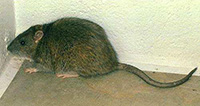Pest control of mice in cold winter weather – Keep them outside!
Homeowners should have enough knowledge about pest control of mice to prevent infestation in their homes. Learn to identify them – what they look like, where they build their nests, and how to get rid of them.
There are essentially three species of mice in the Springfield, Missouri, area that we need to be concerned with – deer mice, house mice, and the white-footed mouse. The house mouse is the smallest in size, about 5½ inches in length. The white-footed mouse is the largest, up to 7½ inches in length. The field mouse can be from 3½ to 7½ inches long. In color, the three species are distinctively different – the house mouse is a grayish-brown color with a mostly hairless tail that is longer than their body. A deer mouse, also referred to as a field mouse, is gray to reddish-brown in color with a white belly and feet, and their tail is shorter, less than half the length of their body. The white-footed mouse is identical to the field mouse in color but larger in size. Each species is nocturnal and quick on their feet.
 If you see a mouse during the daytime, chances are it is a house mouse. A house mouse doesn’t stray far from the nest, while the white-footed mouse likes to venture farther away. They all like to store food in the nest and will eat just about anything – plant leaves and stems, seeds, roots, fruit, berries and insects, and of course, any bits of food they find lying around – and paper, i.e.books and newspapers. As the cold weather of winter approaches, mice will seek shelter inside your home and outbuildings. A deer mouse likes many different habitats such as fields and wooded areas. White-footed mice also like the woods, brushy areas, and farmlands.
If you see a mouse during the daytime, chances are it is a house mouse. A house mouse doesn’t stray far from the nest, while the white-footed mouse likes to venture farther away. They all like to store food in the nest and will eat just about anything – plant leaves and stems, seeds, roots, fruit, berries and insects, and of course, any bits of food they find lying around – and paper, i.e.books and newspapers. As the cold weather of winter approaches, mice will seek shelter inside your home and outbuildings. A deer mouse likes many different habitats such as fields and wooded areas. White-footed mice also like the woods, brushy areas, and farmlands.
All mice reproduce at a prolific rate and can infest your home or other buildings quickly. Anytime you see a mouse or their droppings in the house or hear them skittering inside the walls, it is an obvious sign that you have an infestation. Mouse droppings create a serious health hazard. Pest control of mice is crucial to preventing symptoms of disease. House mice have never been known to give people HPS (hantavirus) but since it is hard to tell if a mouse carries a hantavirus, it is best to avoid all mice and to safely clean up any rodent urine, droppings, or nests in your home. You should actively look for their nests – inside walls, dark closets, or in piles of boxes. Look for chewed up paper or plastic and gnaw marks along edges of wood or other hard materials. Always use respiratory protection when you remove mouse droppings.
For mouse pest control, an integrated pest control approach works best. The species of mice must first be identified and an investigation conducted into where they are nesting. Then an effective treatment plan can be devised and actions taken.
Some types of mouse pest control require chemical treatment methods, but not all do. Your Expert Pest Control technicians will employ whatever method is best suited to your particular situation. Other preventative steps will also be taken, such as sealing any openings that can allow access to your home from outside. This could involve the use of screen wire, flashing, door sweeps or sealants, or the use of traps or bait, both inside and outside the home. Minimizing the availability of food by keeping debris and clutter away also discourages mice from hanging around.
For your Free Inspection for mouse infestation, call Expert Pest Solutions at (417) 413-4776 or visit us online. An associate will call to provide your Free Estimate as soon as possible.
